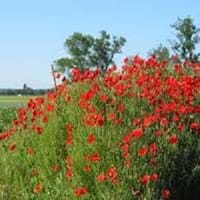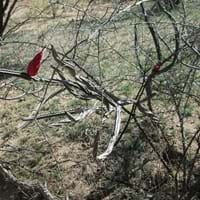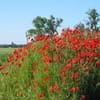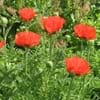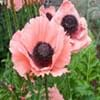Life Span
Perennial
Perennial
Type
Flowering Plants
Flowering Plants
Origin
Europe
Mexico, Caribbean, Central America
Types
Not Available
not available
Habitat
gardens, Grassland, Tropical regions, Urban areas
Desert
USDA Hardiness Zone
5-8
12-15
Sunset Zone
1a, 1b, 2a, 2b, 3a, 3b, 4, 5, 6, 7, 8, 9, 14, 15, 16, 17
H2
Habit
Clump-Forming
Weeping
Flower Color
White, Yellow, Red, Orange, Light Yellow, Lemon yellow, Light Pink, Rose, Salmon, Coral, Peach
White, Ivory
Flower Color Modifier
Bicolor
Not Available
Fruit Color
Not Available
Non Fruiting Plant
Leaf Color in Spring
Gray Green
Green, Dark Green
Leaf Color in Summer
Gray Green
Green, Dark Green
Leaf Color in Fall
Gray Green
Green, Dark Green
Leaf Color in Winter
Not Available
Olive, Dark Green
Leaf Shape
Bracts
Long and slender with very sharp edges
Plant Season
Spring, Summer
Summer
Sunlight
Full Sun
Partial shade
Type of Soil
Loam, Sand
Sand
The pH of Soil
Acidic, Neutral
Neutral, Alkaline
Soil Drainage
Well drained
Well drained
Bloom Time
Late Spring, Early Summer, Summer
Early Summer, Summer
Tolerances
Not Available
Drought
Where to Plant?
Ground, Pot
Container, Ground
How to Plant?
Seedlings, Transplanting
Grafting, Seedlings, Transplanting
Plant Maintenance
Medium
Medium
Watering Requirements
Does not require lot of watering, Water occasionally
Does not require lot of watering, Water once every two or three weeks, Water when soil is dry
In Summer
Lots of watering
Lots of watering
In Spring
Moderate
Moderate
In Winter
Average Water
Average Water
Soil pH
Acidic, Neutral
Neutral, Alkaline
Soil Type
Loam, Sand
Sand
Soil Drainage Capacity
Well drained
Well drained
Sun Exposure
Full Sun
Partial shade
Pruning
Remove damaged leaves, Remove dead branches, Remove dead leaves
Remove damaged leaves, Remove dead branches, Remove dead leaves
Fertilizers
All-Purpose Liquid Fertilizer
All-Purpose Liquid Fertilizer
Pests and Diseases
Red blotch
Aphids, Mealybugs, Root rot, Scale, Viruses
Plant Tolerance
Drought
Drought
Flower Petal Number
Single
Semi-Double
Foliage Texture
Fine
Bold
Foliage Sheen
Matte
Not Available
Attracts
Not Available
Not Available
Allergy
Skin irritation
Not Available
Aesthetic Uses
Showy Purposes
Beautification
Beauty Benefits
Not Available
Not Available
Environmental Uses
Air purification
Air purification
Medicinal Uses
Used as a sedative
Diabetes, Hangover
Part of Plant Used
Whole plant
Flowers, Fruits, Leaves
Other Uses
Used as Ornamental plant
Employed in herbal medicine, Fine spines and trichomes are used as fiber for weaving, Used As Food
Used As Indoor Plant
Yes
No
Used As Outdoor Plant
Yes
Yes
Garden Design
Alpine, Container, Cutflower, Mixed Border, Rock Garden / Wall, Wildflower
Container, Hanging Basket, Houseplant, Tropical
Botanical Name
PAPAVER alpinum
Peniocereus greggii
Common Name
Alpine Poppy
Night Blooming Cereus, Reina de la noche, Arizona queen of the night
In Hindi
अल्पाइन पोस्ता
Night Blooming Cereus
In German
Alpine Mohn
Nachtblühende Cereus
In French
Alpine Poppy
Night Blooming Cereus
In Spanish
Alpine amapola
Reina de la noche
In Greek
Alpine παπαρούνας
Night Blooming Cereus
In Portuguese
Alpine Poppy
Night Blooming Cereus
In Polish
Alpine Poppy
Noc Blooming Cereus
In Latin
Alpini Poppy
Maria Maria Cereus
Phylum
Not Available
Magnoliophyta
Class
Dicotyledonae
Magnoliopsida
Order
Ranunculales
Caryophyllales
Family
Papaveraceae
Cactaceae
Genus
Papaver
Peniocereus
Clade
Angiosperms, Eudicots
Angiosperms, Core eudicots, Eudicots
Tribe
Not Available
Pachycereeae
Subfamily
Paperveroideae
Cactoideae
Number of Species
Not Available
Difference Between Alpine Poppy and Night Blooming Cereus
If you are confused whether Alpine Poppy or Night Blooming Cereus are same, here are some features about those plants to help you choose better. Many people think that these two plants have the same characteristics, but one can see Alpine Poppy and Night Blooming Cereus Information and learn more about it. Fertilizers required for proper growth of Alpine Poppy are All-Purpose Liquid Fertilizer, whereas for Night Blooming Cereus fertilizers required are All-Purpose Liquid Fertilizer. Hence, one should know the basic difference between Alpine Poppy and Night Blooming Cereus if you are planning to have them in your garden to enhance its beauty.
<
Flowering PlantsImportance of Alpine Poppy and Night Blooming Cereus
Want to have the most appropriate plant for your garden? You might want to know the importance of Alpine Poppy and Night Blooming Cereus. Basically, these two plants vary in many aspects. Compare Alpine Poppy and Night Blooming Cereus as they differ in many characteristics such as their life, care, benefits, facts, etc. Every gardener must at least have the slightest clue about the plants he wants to plant in his garden. Compare their benefits, which differ in many ways like facts and uses. The medicinal use of Alpine Poppy is Used as a sedative whereas of Night Blooming Cereus is Diabetes and Hangover. Alpine Poppy has beauty benefits as follows: Not Available while Night Blooming Cereus has beauty benefits as follows: Not Available.
Compare Facts of Alpine Poppy vs Night Blooming Cereus
How to choose the best garden plant for your garden depending upon its facts? Here garden plant comparison will help you to solve this query. Compare the facts of Alpine Poppy vs Night Blooming Cereus and know which one to choose. As garden plants have benefits and other uses, allergy is also a major drawback of plants for some people. Allergic reactions of Alpine Poppy are Skin irritation whereas of Night Blooming Cereus have Not Available respectively. Having a fruit bearing plant in your garden can be a plus point of your garden. Alpine Poppy has no showy fruits and Night Blooming Cereus has showy fruits. Also Alpine Poppy is not flowering and Night Blooming Cereus is not flowering . You can compare Alpine Poppy and Night Blooming Cereus facts and facts of other plants too.
